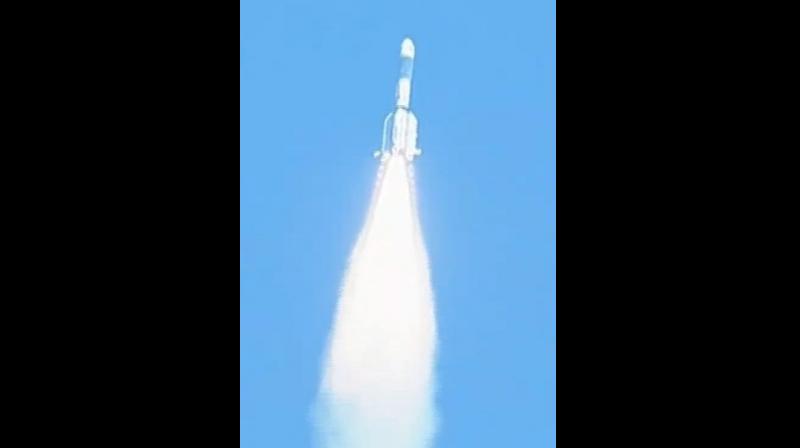Now, Indian Air Force gets dedicated satellite boost

Sriharikota: Indian Space Research Organisation successfully launched GSAT-7A, a dedicated communication satellite for Indian Air Force that will connect IAF assets like planes, air-borne early warning control systems, drones and ground stations, on Wednesday.
The satellite is expected to enhance operations of IAF besides giving a major push to drones by improving ran-ge and endurance.
It will also reduce the reliance on ground control stations. Th-ough Isro officials rema-ined tight lipped about the use of the satellite, sources indicated that it was built for strategic purposes.
With almost 50 metres tall, GSLV-F11, the improved version of GSLV-Mk II, has lifted off with the GSAT-7A satellite from the second launch pad in Satish Dhawan Space Centre at 4.10 pm. After a flight of 19 minutes, the rocket placed the satellite into the temporary orbit.
It achieved an orbit with the apogee of 39,127 km and perigee of 170 km.
The improved cryogenic stage of the rocket has launched the satellite into an orbit with farthest point beyond 36,000 km from Earth. This orbit is known as super-synchronous transfer orbit and will consume lesser fuel to reach the geo-stationary orbit.
“The cryogenic stage was burnt to depletion to achieve super-syncrhonous transfer orbit. We have got 2,000 km over expectations and it will require less fuel to achieve final orbit, enhancing the life of the satellite," Isro chairman K. Sivan said after the launch.
This is the sixth consecutive success of GSLV rocket. There are so many developments in the vehicle as well as the satellite.
"The second stage propellant capacity has been increased from 37.5 tonnes to 40 tonnes and cryogenic stage propellant loading was increased from 12 tonnes to 15 tonnes to give added thrust to the final stage," Sivan said.
He further said the launch has given anxious moments for the scientists due to the cyclone Phethai. It made landfall a few hundred kilometres away from Sriharikota on Monday.
"This is the last mission of Isro in this year and we are looking to the new year with the grand mission of Chandrayaan-2," Isro chairman said. Vikram Sarabhai Space Centre director S.Somanath explained the modifications made in the GSLV Mk II rocket.
“GSLV F-11 rocket is 1.5 metre taller than other GSLV rockets. The future rockets GSLV F-10, GSLV F-12 will accommodate bigger payloads due to the changes made in the design,” he said.
Space Application Centre’s director D.K. Das said the payload of the satellite consists 10 Ku band transponders and offset Gregorian antenna to give communication capability to the users over the Indian region. The antenna will ensure uninterrupted communication even during heavy weather conditions.
Soon after the separation of the satellite, Master Control Facility (MCF) at Hassan in Karnataka took over the command and control of GSAT-7A.
In the coming days, the satellite will be placed in geo-stationary orbit by firing on board propulsion system.
Isro to send 32 missions next year
Indian Space Research Organisation to send 32 missions next year including the rockets and satellites, according to Isro chairman K.Sivan.
After ending the 2018 on high with the successful launch of GSLV-F11 rocket, Mr. Sivan said, “We have launched three communication satellites in 35 days
This year the space organisation has undertaken 17 missions including seven launches from Sriharikota.”
In 2019 first quarter, Isro is planning to launch Chandrayaan-2 and a host of next generation remote sensing and communication satellites.

